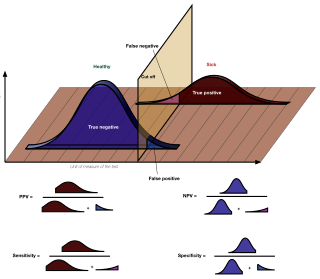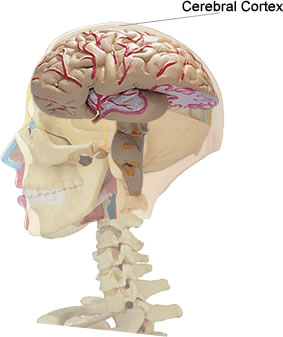
Dyslexia, previously known as word blindness, is a learning disability that affects either reading or writing. Different people are affected to different degrees. Problems may include difficulties in spelling words, reading quickly, writing words, "sounding out" words in the head, pronouncing words when reading aloud and understanding what one reads. Often these difficulties are first noticed at school. The difficulties are involuntary, and people with this disorder have a normal desire to learn. People with dyslexia have higher rates of attention deficit hyperactivity disorder (ADHD), developmental language disorders, and difficulties with numbers.

Hyperlexia is a syndrome characterized by a child's precocious ability to read. It was initially identified by Norman E. Silberberg and Margaret C. Silberberg (1967), who defined it as the precocious ability to read words without prior training in learning to read, typically before the age of five. They indicated that children with hyperlexia have a significantly higher word-decoding ability than their reading comprehension levels. Children with hyperlexia also present with an intense fascination for written material at a very early age.

The theory of multiple intelligences proposes the differentiation of human intelligence into specific intelligences, rather than defining intelligence as a single, general ability. The theory has been very popular among educators around the world for 40 years despite being criticized by mainstream psychology for its lack of empirical evidence, and its dependence on subjective judgement.
Human intelligence is the intellectual capability of humans, which is marked by complex cognitive feats and high levels of motivation and self-awareness. Using their intelligence, humans are able to learn, form concepts, understand, and apply logic and reason. Human intelligence is also thought to encompass our capacities to recognize patterns, plan, innovate, solve problems, make decisions, retain information, and use language to communicate.
Psychological testing refers to the administration of psychological tests. Psychological tests are administered or scored by trained evaluators. A person's responses are evaluated according to carefully prescribed guidelines. Scores are thought to reflect individual or group differences in the construct the test purports to measure. The science behind psychological testing is psychometrics.
Critical thinking is the analysis of available facts, evidence, observations, and arguments in order to form a judgement by the application of rational, skeptical, and unbiased analyses and evaluation. The application of critical thinking includes self-directed, self-disciplined, self-monitored, and self-corrective habits of the mind, thus a critical thinker is a person who practices the skills of critical thinking or has been trained and educated in its disciplines. Philosopher Richard W. Paul said that the mind of a critical thinker engages the person's intellectual abilities and personality traits. Critical thinking presupposes assent to rigorous standards of excellence and mindful command of their use in effective communication and problem solving, and a commitment to overcome egocentrism and sociocentrism.
Inferences are steps in reasoning, moving from premises to logical consequences; etymologically, the word infer means to "carry forward". Inference is theoretically traditionally divided into deduction and induction, a distinction that in Europe dates at least to Aristotle. Deduction is inference deriving logical conclusions from premises known or assumed to be true, with the laws of valid inference being studied in logic. Induction is inference from particular evidence to a universal conclusion. A third type of inference is sometimes distinguished, notably by Charles Sanders Peirce, contradistinguishing abduction from induction.
An aptitude is a component of a competence to do a certain kind of work at a certain level. Outstanding aptitude can be considered "talent". Aptitude is inborn potential to perform certain kinds of activities, whether physical or mental, and whether developed or undeveloped. Aptitude is often contrasted with skills and abilities, which are developed through learning. The mass term ability refers to components of competence acquired through a combination of both aptitude and skills.
The concepts of fluid intelligence (gf) and crystallized intelligence (gc) were introduced in 1963 by the psychologist Raymond Cattell. According to Cattell's psychometrically-based theory, general intelligence (g) is subdivided into gf and gc. Fluid intelligence is the ability to solve novel reasoning problems and is correlated with a number of important skills such as comprehension, problem-solving, and learning. Crystallized intelligence, on the other hand, involves the ability to deduce secondary relational abstractions by applying previously learned primary relational abstractions.
In logic, statistical inference, and supervised learning, transduction or transductive inference is reasoning from observed, specific (training) cases to specific (test) cases. In contrast, induction is reasoning from observed training cases to general rules, which are then applied to the test cases. The distinction is most interesting in cases where the predictions of the transductive model are not achievable by any inductive model. Note that this is caused by transductive inference on different test sets producing mutually inconsistent predictions.
Cognitive tests are assessments of the cognitive capabilities of humans and other animals. Tests administered to humans include various forms of IQ tests; those administered to animals include the mirror test and the T maze test. Such testing is used in psychology and psychometrics, as well as other fields studying human and animal intelligence.
The Wechsler Intelligence Scale for Children (WISC) is an individually administered intelligence test for children between the ages of 6 and 16. The Fifth Edition is the most recent version.

In medicine and statistics, sensitivity and specificity mathematically describe the accuracy of a test that reports the presence or absence of a medical condition. If individuals who have the condition are considered "positive" and those who do not are considered "negative", then sensitivity is a measure of how well a test can identify true positives and specificity is a measure of how well a test can identify true negatives:
Language learning aptitude refers to the "prediction of how well, relative to other individuals, an individual can learn a foreign language in a given amount of time and under given conditions". Foreign language aptitude itself has been defined as a set of cognitive abilities which predicts L2 learning rate, or how fast learners can increase their proficiency in a second or foreign language, and L2 ultimate attainment, or how close learners will get to being able to communicate like a native in a second or foreign language, both in classroom and real-world situations. Understanding aptitude is crucial for a complete picture of the process of second language acquisition. Knowledge about language aptitude has profound impacts in the field of Applied Linguistics, particularly in Second Language Acquisition (SLA) theory and in the practice of teaching and learning languages.

Analytical skill is the ability to deconstruct information into smaller categories in order to draw conclusions. Analytical skill consists of categories that include logical reasoning, critical thinking, communication, research, data analysis and creativity. Analytical skill is taught in contemporary education with the intention of fostering the appropriate practises for future professions. The professions that adopt analytical skill include educational institutions, public institutions, community organisations and industry.
Elizabeth Kerr Warrington FRS is a British neuropsychologist specialised in the study of dementia. She holds a PhD in Psychology visual processing and is now an emeritus professor of clinical neuropsychology at the University College London. She formerly worked as the Head of the Department of Neuropsychology at the National Hospital for Neurology and Neurosurgery where she is also a member of the Dementia Research Centre. She was made a Fellow of the Royal Society in 1986.
The psychology of reasoning is the study of how people reason, often broadly defined as the process of drawing conclusions to inform how people solve problems and make decisions. It overlaps with psychology, philosophy, linguistics, cognitive science, artificial intelligence, logic, and probability theory.
Implicit learning is the learning of complex information in an unintentional manner, without awareness of what has been learned. According to Frensch and Rünger (2003) the general definition of implicit learning is still subject to some controversy, although the topic has had some significant developments since the 1960s. Implicit learning may require a certain minimal amount of attention and may depend on attentional and working memory mechanisms. The result of implicit learning is implicit knowledge in the form of abstract representations rather than verbatim or aggregate representations, and scholars have drawn similarities between implicit learning and implicit memory.
Fuzzy-trace theory (FTT) is a theory of cognition originally proposed by Valerie F. Reyna and Charles Brainerd to explain cognitive phenomena, particularly in memory and reasoning.
Prosodic bootstrapping in linguistics refers to the hypothesis that learners of a primary language (L1) use prosodic features such as pitch, tempo, rhythm, amplitude, and other auditory aspects from the speech signal as a cue to identify other properties of grammar, such as syntactic structure. Acoustically signaled prosodic units in the stream of speech may provide critical perceptual cues by which infants initially discover syntactic phrases in their language. Although these features by themselves are not enough to help infants learn the entire syntax of their native language, they provide various cues about different grammatical properties of the language, such as identifying the ordering of heads and complements in the language using stress prominence, indicating the location of phrase boundaries, and word boundaries. It is argued that prosody of a language plays an initial role in the acquisition of the first language helping children to uncover the syntax of the language, mainly due to the fact that children are sensitive to prosodic cues at a very young age.




